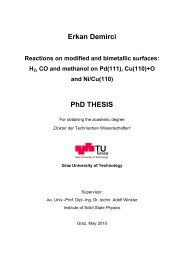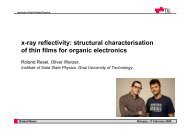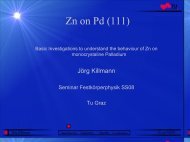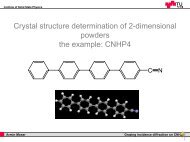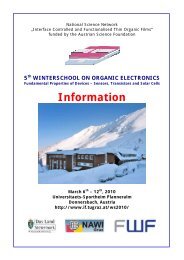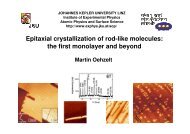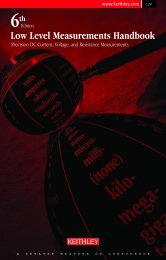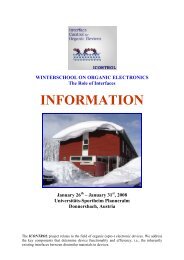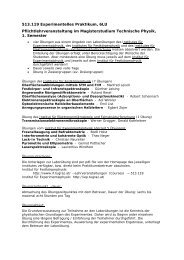Very Sharp Platinum Tips by Electrochemical Etching
Very Sharp Platinum Tips by Electrochemical Etching
Very Sharp Platinum Tips by Electrochemical Etching
Create successful ePaper yourself
Turn your PDF publications into a flip-book with our unique Google optimized e-Paper software.
2 State of the art Martin Kupper 0830965rall profiles, <strong>by</strong> transmission electron microsification,of tungsten tips of decreasing conetwo-step etching. They display many minitipsat appears independent of their location alongwith water and alcohol for removregularlayer of electrolyte residue,ediately in an inert medium such asavoid oxidation or thin film depositsuntil actual use.true atomic or near-atomic sharpness,e were imaged with a high-resolutionmicroscope model Hitachi H-800NAand optimized for 0.26 nm point-to-ic profiles of tips sharpened <strong>by</strong> reprogressivelydecreasing cone anglesat low magnification. They illustratel ultrasharp minitips or spikes alongabsence of correlation between coned spike sharpness. The removal of therinsing in water and alcohol does notpness, as displayed <strong>by</strong> the very sharpic radius OS-l.0 nm and half-cone. To put in perspective the tip profilepness yielded <strong>by</strong> reverse etching andmbody in comparison with typical tipnormal etching, a clean minitip ofs (subnanometer radius) is shown inat the same magnification, on thesharp tungsten minitips of near-atomic radiushalf-cone (y-14’) unaltered <strong>by</strong> rinsing withFIG. 5. Tip of near-atomic sharpness of apex radius about 0.5-1.0 nm,formed Figure <strong>by</strong> reverse 2.2: ac Aetching reverse-etched (inside), contrasted tungsten at the same tip. magnitica- [3]tion with the outlined profile of a typically sharp apex of lOO-nm radiusformed <strong>by</strong> normal ac etching (outside).2.2 <strong>Tips</strong> for resistivity measurements.outlined profile of an optimal tip of about 100 nm radiusproduced <strong>by</strong> standard etching.In summary, a new procedure has been developed forthe production <strong>by</strong> electrochemical etching of ultrasharptungsten tips of nanometer and subnanometer apex dimensionsand its mechanism based on bubble dynamics brieflydiscussed. <strong>Tips</strong> are etched in NaOH under ac voltage intwo slow steps: In the first, a narrow cone with a fairlyblunt tip is produced, and in the second, the final sharpeningis accomplished in a modified configuration in whichthe wire is immersed pointing upward.The procedure can be extended to other metals withappropriate electrolytes.More broadly, beyond scanning probe microscopy, ultrasharptips also have applications in nanolithography,low-voltage cold-cathode field emitters, nanoelectronics,electrochemistry, field-ion and electron microscopy, andcell biology.The author is greatly indebted to Professor Noel A.Clark for use of the STM and etching setup in the CondensedMatter Laboratory and to Professor Arnold0 Majerfeldand Dr. Tamsin McCormick for use of the HitachiH-800NA transmission electron microscope in the AtomicResolution STEM Laboratory on the Boulder Campus.<strong>Sharp</strong> tips are also used for resistivity measurements in an SEM [1], where the currentdistribution of small devices is being measured. To do that, sharp tips are mountedin micromanipulators, are installed in an SEM. The tips are placed on the device, tomake electrical contact, a voltage is applied and the drop measured. In general, thereare two ways to make these measurements: first the normal resistivity measurementwith two tips, and secondly the four point resistivity measurement. For the four pointmeasurement the tips are placed in a row, a current applied between the two outer tipsand the voltage drop measured between the two inner tips (see Fig.2.3). In addition,the problem with this measurement is the tips. As mentioned in chapter 1 they bendwhen they are landed on a sample (see Fig.2.4). Because it can only be estimatedwhere the tips make contact, it is that way a relatively inaccurate measurement. Forfurther information concerning this method, visit the hompage of the Institute of SolidState Physics from the TU Graz [1].‘G. Binnig, H. Rohrer, Ch. Gerber, and E. Weibel, Phys. Rev. Lett. 49,57 (1982); 50, 120 (1983).‘G. Binnig, C. F. Quate, and Ch. Gerber, Phys. Rev. Lett. 56, 930(1986).‘J. Tersoff and D. R. Hamann, Phys. Rev. Lett. 50, 1998 (1983); Phys.Rev. B 31, 805 (1985).4T. E. Feuchtwang, P. H. Cutler, and N. M. Miskovsky, Phys. Lett. A99, 167 (1983).‘N. D. Lang, Phys. Rev. Lett. 55, 230 (1985); 56, 1164 (1986).bJ. K. Gimzewski, A. Humbert, J. G. Bednorz, and B. Reihl, Phys. Rev.Lett. 55, 951 (1985).‘Y. Kuk and P. J. Silverman, Appl. Phys. Lett. 48, 1597 (1986).‘R. Chicon, M. Ortuno, and J. Abellan, Surf. Sci. 181, 107 (1987).‘P. K. Hansma and J. Tersoff, J. Appl. Phys. 61, Rl (1987).“J. E. Demuth, U. Koehler, and R. J. Hamers, 5. Microsc. 152, 299(1988).*lY. Kuk and P. J. Silverman, Rev. Sci. Instrum. 60, 165 (1989).“L. L. Soethout, H. van Kempen, and G. F. A. van de Walle, Adv..Electron. El. Phys. 79, 155 (1990).13A. J. Mehned, J. Vat. Sci. Technol. B 9, 601 (1991).14M. Fotino, Proc. Annu. Meet. EMSA 49, 386 ( 1991).Figure 2.3: Diagram of a four point measurement [1].tt., Vol. 60, No. 23, 8 June 1992 M. Fotino 2937ded 12 Jan 2012 to 129.27.158.207. Redistribution subject to AIP license or copyright; see http://apl.aip.org/about/rights_and_permissions5



